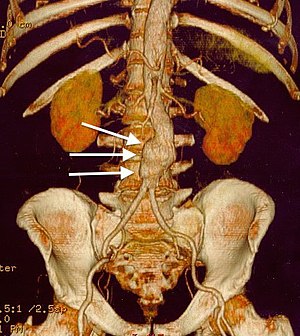ท่อเลือดแดงส่วนท้องโป่งพอง
เอออร์ตาส่วนท้องโป่งพอง (อังกฤษ: abdominal aortic aneurysm, AAA) คือภาวะที่หลอดเลือดเอออร์ตาส่วนท้องมีขนาดใหญ่กว่าปกติ (มีเส้นผ่านศูนย์กลางมากกว่า 1.5 เท่า ของขนาดปกติ) และเป็น aortic aneurysm ที่พบบ่อยที่สุด ส่วนใหญ่เกิดใต้หลอดเลือดแดงไต (infrarenal) แต่ก็อาจมีเกิดเหนือหลอดเลือดแดงไต (suprarenal) และที่หลอดเลือดแดงไต (pararenal) ได้ อาจกินบริเวณลามไปถึงได้ด้วย
| เอออร์ตาส่วนท้องโป่งพอง (Abdominal aortic aneurysm) | |
|---|---|
| ชื่ออื่น | Triple-A |
 | |
| CT reconstruction image of an abdominal aortic aneurysm (white arrows) | |
| สาขาวิชา | ศัลยศาสตร์หลอดเลือด |
| อาการ | ไม่มีอาการ, ปวดท้อง, ปวดหลัง, ปวดขา[1][2] |
| การตั้งต้น | Over 50 years old males[1] |
| ปัจจัยเสี่ยง | Smoking, high blood pressure, other heart or blood vessel diseases, family history, Marfan syndrome[3][1][4] |
| วิธีวินิจฉัย | Medical imaging (abdominal aorta diameter > 3 cm)[1] |
| การป้องกัน | Not smoking, treating risk factors[1] |
| การรักษา | Surgery (open surgery or endovascular aneurysm repair)[1] |
| ความชุก | ~5% (males over 65 years)[1] |
| การเสียชีวิต | 168,200 aortic aneurysms (2015)[5][6] |
AAA ส่วนใหญ่เกิดในคนอายุ 25-30ปี ส่วนใหญ่พบในผู้ชายและผู้ที่สูบบุหรี่ มักไม่ทำให้มีอาการ บางครั้งอาจทำให้มีอาการปวดท้องหรือปวดหลัง (เนื่องจากหลอดเลือดที่โป่งไปเบียดเนื้อเยื่อข้างเคียง) หรือปวดขา (เนื่องจากรบกวนการไหลของเลือด) ภาวะแทรกซ้อนที่สำคัญที่สุดของ AAA คือการแตก ซึ่งมีอันตรายถึงชีวิต เลือดจำนวนมากจะไหลเข้าไปในช่องท้อง ทำให้เสียชีวิตได้ภายในเวลาไม่กี่นาที อัตราตายของผู้ป่วย AAA แตก ที่เข้ารับการรักษาในโรงพยาบาลอยู่ที่ 60-90%
การผ่าตัดรักษา AAA มีความเสี่ยงสูงมาก ศัลยแพทย์มักให้คำแนะนำว่าผู้ป่วยที่มี AAA ขนาดใหญ่ (เส้นผ่านศูนย์กลางมากกว่า 5.5 เซนติเมตร) จะมีความเสี่ยงที่จะเกิดการแตกมากกว่าความเสี่ยงที่จะเกิดผลแทรกซ้อนจากการผ่าตัด วิธีการผ่าตัดทำได้ทั้งแบบเปิดหน้าท้องเข้าไปซ่อมแซมหลอดเลือด และแบบ endovascular ที่สอดหลอดเลือดเข้าไปทางหลอดเลือดแดงขาหนีบแล้วไปขึ้นรูปภายใน
อ้างอิง
แก้- ↑ 1.0 1.1 1.2 1.3 1.4 1.5 1.6 Kent KC (27 November 2014). "Clinical practice. Abdominal aortic aneurysms". The New England Journal of Medicine. 371 (22): 2101–8. doi:10.1056/NEJMcp1401430. PMID 25427112.
- ↑ Upchurch GR, Schaub TA (2006). "Abdominal aortic aneurysm". Am Fam Physician. 73 (7): 1198–204. PMID 16623206.
- ↑ Wittels K (November 2011). "Aortic emergencies". Emergency Medicine Clinics of North America. 29 (4): 789–800, vii. doi:10.1016/j.emc.2011.09.015. PMID 22040707.
- ↑ "Aortic Aneurysm Fact Sheet". cdc.gov. July 22, 2014. เก็บจากแหล่งเดิมเมื่อ 3 February 2015. สืบค้นเมื่อ 3 February 2015.
- ↑ GBD 2015 Mortality and Causes of Death, Collaborators. (8 October 2016). "Global, regional, and national life expectancy, all-cause mortality, and cause-specific mortality for 249 causes of death, 1980–2015: a systematic analysis for the Global Burden of Disease Study 2015". Lancet. 388 (10053): 1459–1544. doi:10.1016/s0140-6736(16)31012-1. PMC 5388903. PMID 27733281.
{{cite journal}}:|first1=มีชื่อเรียกทั่วไป (help) - ↑ GBD 2013 Mortality Causes of Death Collaborators (17 December 2014). "Global, regional, and national age-sex specific all-cause and cause-specific mortality for 240 causes of death, 1990-2013: a systematic analysis for the Global Burden of Disease Study 2013". Lancet. 385 (9963): 117–71. doi:10.1016/S0140-6736(14)61682-2. PMC 4340604. PMID 25530442.
{{cite journal}}:|author1=มีชื่อเรียกทั่วไป (help)
แหล่งข้อมูลอื่น
แก้| การจำแนกโรค | |
|---|---|
| ทรัพยากรภายนอก |